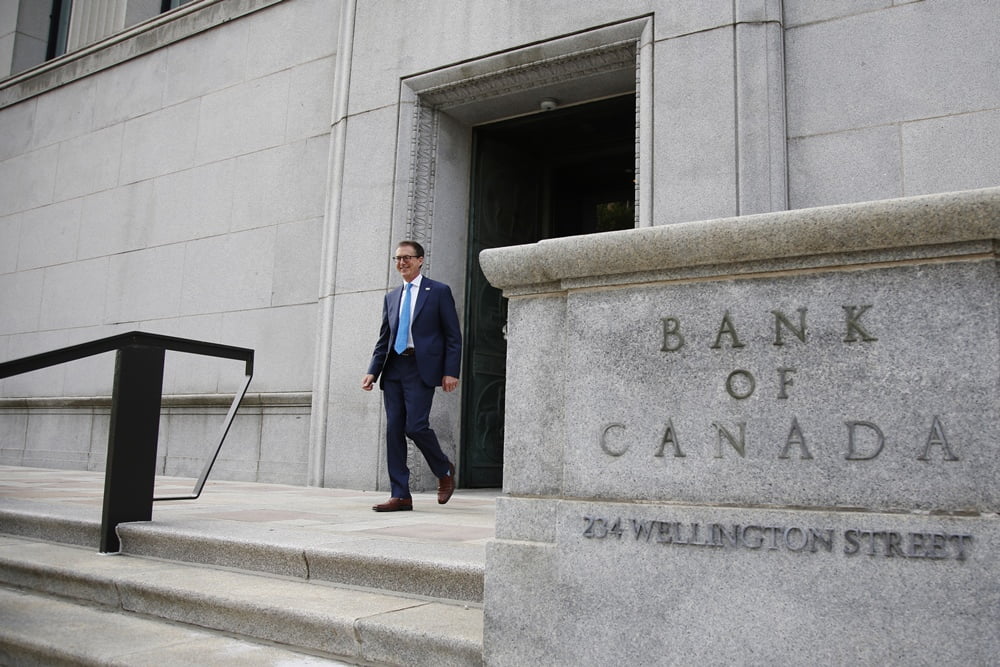The Bank of Canada plays a crucial role in the financial lives of Canadians. Whether it’s the interest rate on your mortgage, the prices you see in stores, or the security of your bank deposits, the Bank of Canada is behind the scenes, working to keep Canada’s economy balanced and resilient.
What you need to know about the Bank of Canada:
The Bank of Canada’s main goals: Inflation and financial stability
The Bank of Canada’s top priority is to keep inflation low and stable, aiming for a target of 2% annually. When inflation is within this range, prices remain relatively stable, making it easier for Canadians to plan for the future, buy homes, and save for retirement.
The Bank manages inflation and promotes economic well-being through its control of interest rates. When inflation rises too quickly, the Bank may increase interest rates to cool spending and borrowing. Conversely, if the economy slows down, the Bank may reduce rates to encourage borrowing and investment, stimulating growth. This decision-making process is led by the Governing Council, which includes top economic experts like the Governor and Deputy Governors.
Cole Burston/Bloomberg via Getty Images
How the Bank of Canada’s decisions affect you
The Bank of Canada’s interest rate decisions impact Canadians in many ways:
Consumer prices: By controlling inflation, the Bank helps stabilize the cost of everyday goods, from groceries to gas. When inflation runs high, the Bank’s measures aim to prevent steep price hikes, helping consumers’ incomes go further.
Mortgage rates: When the Bank raises its overnight rate, variable mortgage rates often increase, making monthly payments higher for those with variable-rate mortgages. Fixed rates, influenced by bond yields, can also rise with Bank decisions, affecting new mortgage seekers.
Credit card and loan rates: Many personal and business loans are linked to the Bank’s rates. An increase or decrease in rates affects everything from credit card interest to personal loans.
Keeping Canada’s financial system stable and secure
Beyond controlling inflation, the Bank of Canada helps ensure Canada’s financial system remains stable and resilient.
This involves assessing risks, conducting “stress tests” for banks, and collaborating with other regulatory agencies like the Office of the Superintendent of Financial Institutions (OSFI) to protect against potential economic shocks. By doing this, the Bank supports a secure banking environment, so Canadians can trust that their financial institutions are safe.
How the Bank of Canada supports the economy during tough times
During financial crises, such as the 2008 global downturn or the COVID-19 pandemic, the Bank of Canada quickly lowered interest rates to ease financial pressures on Canadians. Lowering rates during these times encourages businesses and individuals to spend and invest, helping the economy recover more quickly.
The Bank also provides liquidity support to financial institutions in times of crisis, ensuring that banks have enough funds to keep lending to households and businesses. This prevents a credit freeze that could worsen an economic slowdown.
The Bank of Canada’s 2025 monetary policy meeting schedule
- Wednesday, March 12
- Wednesday, April 16 (With MPR)
- Wednesday, June 4
- Wednesday, July 30 (With MPR)
- Wednesday, September 17
- Wednesday, October 29 (With MPR)
- Wednesday, December 10
The Bank of Canada in action — a historical look
The Bank of Canada has a long history of adjusting the overnight interest rate to manage monetary policy and influence economic conditions in Canada. Here’s a look at some significant overnight rate changes over the years:
- Early Years (1930s-1950s): During the Great Depression of the 1930s, the Bank of Canada was established to stabilize the economy. In 1935, it introduced the overnight rate as a policy tool. Throughout this period, the Bank used rate changes to support economic recovery and maintain price stability.
- Inflation Control (1960s-1980s): In the 1960s and 1970s, Canada faced high inflation rates. To combat inflation, the Bank of Canada implemented tighter monetary policies, raising the overnight rate significantly. In 1981, the overnight rate reached a peak of 21% as the Bank aggressively tightened policy to curb inflationary pressures.
- Reducing Inflation (1990s): In the early 1990s, the Bank of Canada shifted its focus to reducing inflation to more manageable levels. It gradually lowered the overnight rate, reaching a low of 0.75% in 1994. The Bank’s efforts helped bring inflation under control and stabilize the economy.
- Financial Crisis and Stimulus (2000s): In response to the global financial crisis in 2008, the Bank of Canada reduced the overnight rate dramatically to stimulate the economy. The rate was lowered from 4.50% in early 2008 to a historic low of 0.25% in 2009. The low rates aimed to encourage borrowing and spending to support economic recovery.
- Post-Crisis Normalization (2010s): As the economy began to recover, the Bank of Canada gradually raised the overnight rate to more normal levels. From 2010 to 2017, the rate increased in several steps, reaching a peak of 1.75% in 2018. The Bank aimed to balance economic growth with inflation concerns during this period.
- Recent Rate Adjustments (2020s): In response to the COVID-19 pandemic, the Bank of Canada once again made significant rate adjustments. As the pandemic hit, the Bank swiftly reduced the overnight rate from 1.75% in early 2020 to a low of 0.25% to support the economy. As the recovery progressed, the Bank began gradually raising rates, reaching 1.75% in 2022 before the recent increases.
History of the Bank of Canada overnight rate
| Year | Overnight Rate (%) |
|---|---|
| 2000 | 5.50% |
| 2001 | 4.75% |
| 2002 | 2.75% |
| 2003 | 2.25% |
| 2004 | 2.50% |
| 2005 | 3.00% |
| 2006 | 4.25% |
| 2007 | 4.25% |
| 2008 | 3.00% |
| 2009 | 0.25% |
| 2010 | 1.00% |
| 2011 | 1.00% |
| 2012 | 1.00% |
| 2013 | 1.00% |
| 2014 | 1.00% |
| 2015 | 0.50% |
| 2016 | 0.50% |
| 2017 | 1.00% |
| 2018 | 1.75% |
| 2019 | 1.75% |
| 2020 | 0.25% |
| 2021 | 0.25% |
| 2022 | 1.75% |
| 2023 | 5.00% |
| 2024 | 3.25% |
| 2025 | 2.75% (Last changed on March 12) |
Please note that the table only includes the changes in the overnight rate and not the exact dates or number of rate adjustments made within each year. The rates are presented as a percentage. The current overnight target rate can be found at the Bank of Canada website.
Bank of Canada FAQs
- What is the Bank of Canada’s main goal?
The Bank of Canada aims to keep inflation low and stable, ensuring a healthy, sustainable economy and supporting the stability of the financial system. - How does the Bank of Canada control inflation?
The Bank manages inflation primarily through monetary policy, adjusting interest rates to influence borrowing and spending. It also provides financial services to the government and researches economic trends. - Who decides on interest rate changes?
Interest rate decisions are made by the Bank’s Governing Council, which includes the Governor, the Senior Deputy Governor, and four Deputy Governors. They meet eight times yearly to assess economic conditions. - How does the Bank of Canada influence interest rates?
The Bank controls the overnight rate, which impacts the rates at which financial institutions lend to each other. Changes to this rate ripple through the economy, affecting borrowing costs. - What role does the Bank of Canada play in the financial system?
The Bank acts as the Canadian government’s banker, oversees payment systems, and works to keep the financial system stable. However, individual bank regulation falls primarily to the Office of the Superintendent of Financial Institutions (OSFI). - Does the Bank of Canada regulate banks?
While it helps ensure system-wide stability, direct regulation of banks is handled by OSFI and provincial securities commissions. - Can individuals or businesses borrow from the Bank of Canada?
No, individuals and businesses cannot borrow directly. The Bank provides funding to financial institutions, not to the public directly.
Last modified: March 12, 2025




